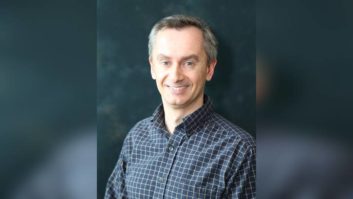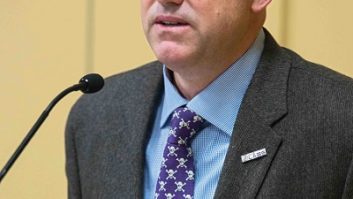Peers of Milford Smith admire his indefatigable dedication to making radio better. They cite his sense of humor and talk about his management skills that enable him to get people representing companies with different agendas to reach a consensus on technical matters concerning digital radio.
Colleagues contacted for this article described Smith as gifted, steadfast and dedicated, especially concerning his two decades of volunteer work for the standards-setting National Radio Systems Committee. Smith, 56, is co-chairman of its DAB Subcommittee. He also has been chairman of the NAB Digital Radio Committee, an advisory committee to the NAB Radio Board.
Smith – widely known as Smitty – led the NRSC through creation of test plans and subsequent evaluation of the initial IBOC systems. He has played a similar role when group repeated the process after the remaining technology developers merged in 2000; through the codec switch in 2004; and now, in finalizing a digital radio standard.
Smith, the vice president of engineering at Greater Media Inc. for the past 21 years, is recipient of this year’s NAB Radio Engineering Achievement Award. The honor is given to industry leaders for significant contributions that have advanced broadcast engineering.
‘Rare breed’
Lynn Claudy, senior vice president of NAB Science and Technology, cites Smith’s “leadership over the past decade” in his DAB Subcommittee role.
“Under his stewardship, numerous pivotal consensus decisions by the radio industry have been achieved on the evaluation, specification and steps toward standardization of a digital radio broadcasting system in the U.S.,” Claudy said. “Milford’s Herculean and tireless efforts on behalf of broadcasters to facilitate a digital future for radio made him the natural choice.”
John Marino, vice president, NAB Science and Technology, said Smith is of a rare breed: “The countless hours he has spent with NRSC to bring new technology to the radio industry clearly shows his insight into how radio can be improved for the benefit of broadcasters and listeners. Smitty is probably the most respected engineer in the business.”
Smith spends about one day a week in Washington on NRSC-related issues, and sometimes two to three days. He said he’s fortunate Greater Media allows him the time and pays the expenses so that he may work on NRSC matters.
“I think it’s terribly important for people in our industry to determine our own destiny,” Smith said. “With the consolidation of the last five to 10 years, in our quest for bigger and better bottom lines, the number of qualified people able to do the (NRSC) work gets smaller. Yet the amount of work doesn’t get smaller as technology ramps up and R&D cycles get faster.
“It’s important to have a hand in our own future, where it’s going and how it’s going to get there.”
Several colleagues noted Smith’s ability to foster communication among opposing parties to find common ground, and his use of humor to do so.
“There were a couple of times through this process where I wondered, ‘How will we ever overcome this issue?’ and he found a way,” said Andy Laird, DOE Journal Broadcast Group.
Some NRSC work is contentious. For example, the members recently created “task groups” to explore surround sound in relation to HD Radio and to review AM bandwidth issues, including the possibility of bandwidth reduction.
Communication skills
Multichannel capability for digital radio has received more attention due to the FCC’s recent clarification of how stations can obtain the right to split their FM digital signals. But multichannel has been a component of the Ibiquity system and is part of the new NRSC-5 standard for IBOC, Smith said.
Smith also is said to be adept at communicating with both managers and technical experts, a trait appreciated by Peter Smyth, president and chief executive officer of Greater Media.
In addition to a leadership on digital radio, Smyth said, “Smitty has contributed to Greater Media’s presence in each of our markets by insuring that we have the best signal coverage possible, significant emergency capability and ‘people friendly’ technical and physical plants.”
As part of his responsibilities, Smith has overseen the digital conversion of Greater Media stations. He predicted that the majority of the company’s stations – those in Boston and nearly all of the Philadelphia facilities – would be converted by this month, with the remaining stations, mostly in suburban New Jersey, done by the end of this year. The company owns 19 stations, 18 of them FMs.
In its announcement, NAB mentioned Smith’s innovative work overseeing the design and replacement of an FM master antenna system atop the Prudential Center in Boston. Four original stations on the system remained on the air from that location, while three more were added without disrupting the other facilities, NAB noted.
Lighting up the roof
Smith told Radio World another challenging aspect of the project was “a mandate from the building that we solve the rooftop RF exposure problem, or we would be dismissed from the building.” The system eventually designed met “tight requirements for downward radiation,” regarding rooftop illumination, he said.
Another notable project was the relocation of KLSX(FM) in Los Angeles to Mt. Wilson. NAB credited him with developing “a unique strategy to relocate this station from an inferior site, in the process creating a full-market signal.”
The move helped the competitive situation for the station, said Smith, who likened the project to a Rubik’s Cube in the number of regulatory approvals needed.
Prior to Greater Media, Smith spent 11 years in a similar position with First Media Corp and several years with Tribune before that. He entered radio as a college student in Vermont, where he grew up. Smith worked as a disc jockey and program director in addition to his chief engineering duties at various stations before choosing engineering as his career.
Smith, his wife Maralee and their daughter live in New Jersey. In his spare time, Smith teaches scuba diving.
Past winners have included Belar’s Arno Meyer, Harris’ Geoff Mendenhall and Infinity’s Glynn Walden. “When you look at the other recipients I’m somewhat awed,” he said. “I feel like I’m walking in the footsteps of giants.”










